HarmonicDyne Poseidon Headphone Review
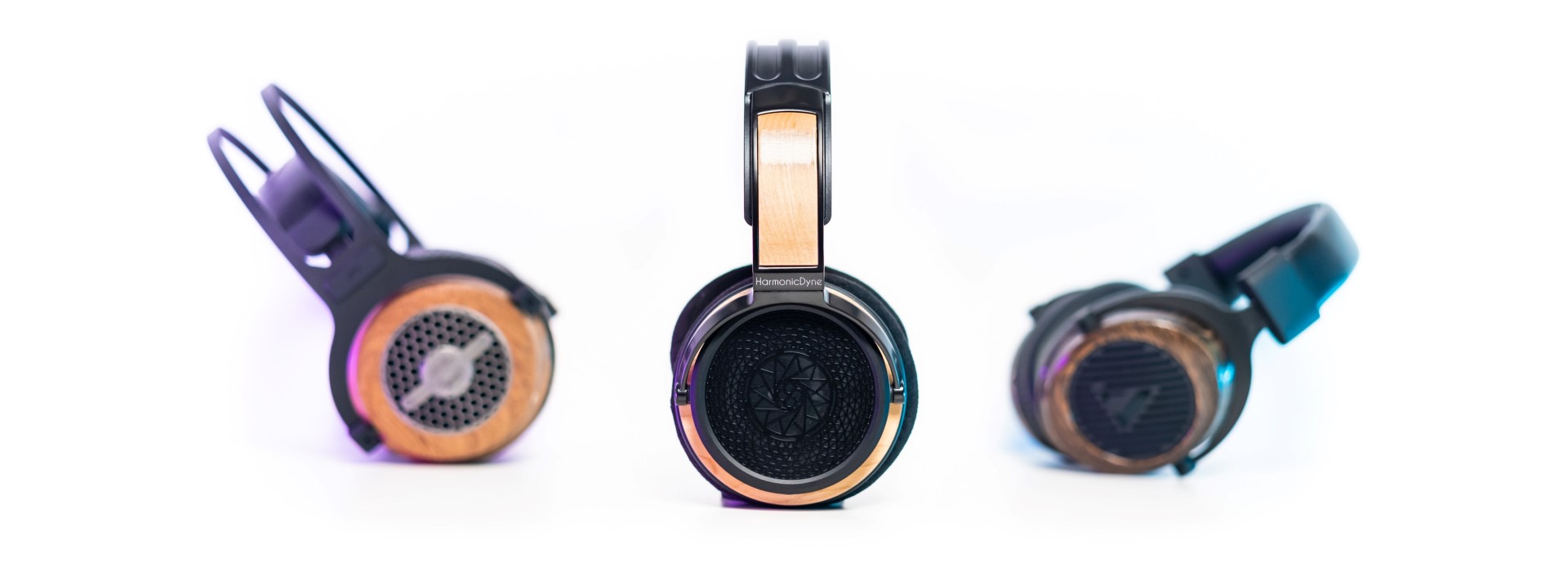
My Video Review:
When Drop.com started branding third-party headphones under their banner and selling them by tens of thousands, Hi-Fi retailers around the globe opened their third eye. That clever move attracted unwanted eyes and it was only a matter of time when HiFi retailers would make their moves, crafting headphones as OEM designs or as their own creations from the ground up. Linsoul is a well-known HiFi retailer that specializes on everything that has to do with earphones and headphones. Personal audio is clearly running through their veins, as such making headphones under their brand would be a logical move to do. Enter HarmonicDyne – the brainchild of Linsoul, that in a short lifespan released two affordable headphones. We all know that the earliest days of a fresh new company are not the brightest, a healthy kickstart is always needed to start the engine and keep the momentum going. Their first Indiegogo campaign was quite successful and a few people backed-up their first ever headphone, the bringer of light in humble beginnings, the sun god Helios itself. When its successor – Zeus hit our eardrums, it became clear that these folks are very serious about audio and even more serious about the whole experience, starting with unboxing and finishing with actual music listening.
A year passed and lessons have been learned, going back to the drawing board and revealing today their future flagship headphone that envisions the god of the sea, storms and earthquakes, the mighty Poseidon taking the shape of a beautiful headphone. I already see plenty of improvements in terms of looks, accessories, driver materials and of course acoustics. Poseidon is priced at $435 and that’s quite an aggressive move considering its fierce competition in the same price bracket. Are they worth it though? Let’s check that out and break it down step by step, in a very customary (comprehensive) way.
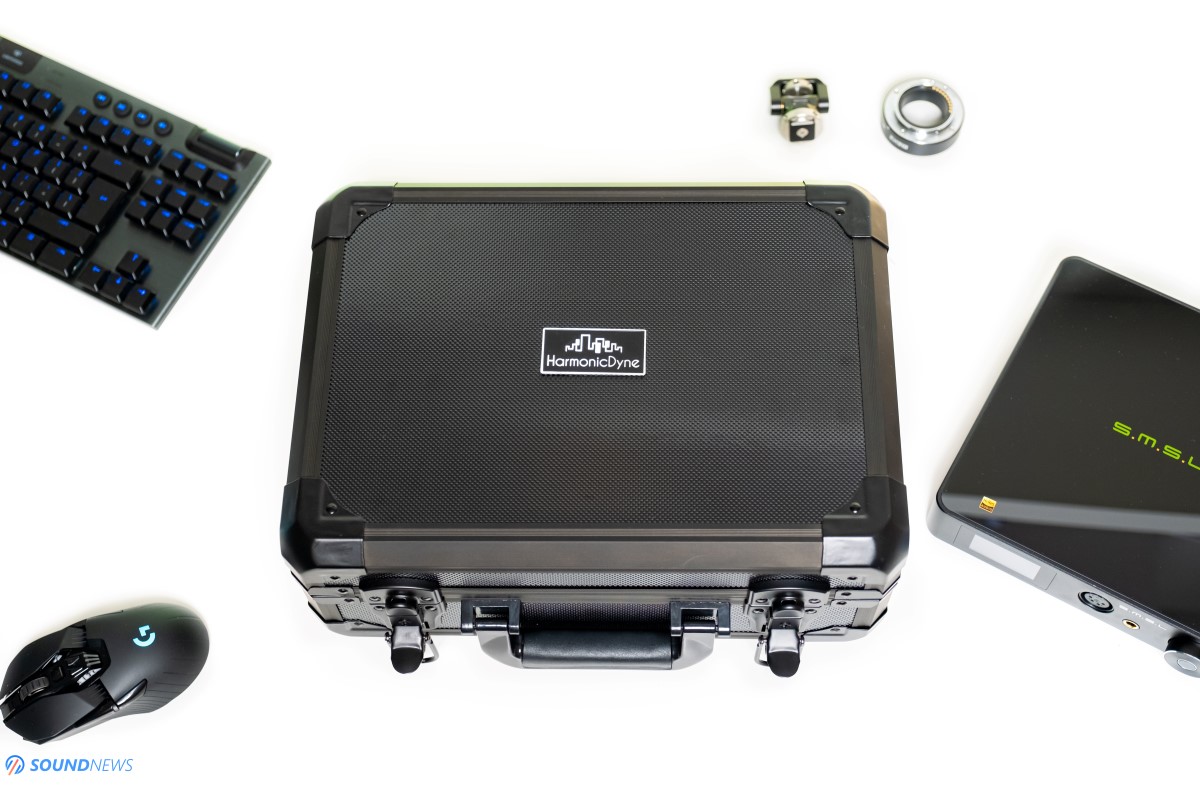
Unboxing Experience
It’s not that often when an affordable headphone is coming in a metal case that holds them and their accessories together. I wasn’t surprised, as their predecessor (Zeus) came in a matching case. It’s not exactly on the same level with Pelican cases, that Audeze is using with their flagship headphones, but it has the same purpose and it looks quite similar, choosing thin layers of metal instead of plastic. The case has even two keys that will lock it, just in case you’ll travel with them around the world. Every Poseidon have a serial number stamped on them and o a metal plate in the carry case – that’s a small thing, but it adds some value to the whole package. The unboxing experience is top-notch and I wish more headphone manufacturers would adopt a functional travel case, rather than an impractical display case, that some are bundling with their headphones. Besides the cans themselves that are surrounded by plenty of foam as an extra protection measure, to their right there is an accessory compartment that contains a user manual in English and Chinese, a high-quality headphone cable terminated with a 4-pin XLR jack and a headphone adapter so you can use them with usual 6.35mm (1/4”) headphone outputs.
I’m surprised by the cable quality, which is much thicker to stock cables I’m seeing on many pricier headphones. It feels strong and durable, it’s surrounded by a textile outer jacket and uses sturdy metal connectors. It feels more like a custom cable, rather like a stock one, they didn’t spare a dime on the cable conductors, as high-purity copper was used in here. Considering its thickness, outer jacket and cable conductors, I don’t see the point of getting third-party cables with this particular model.
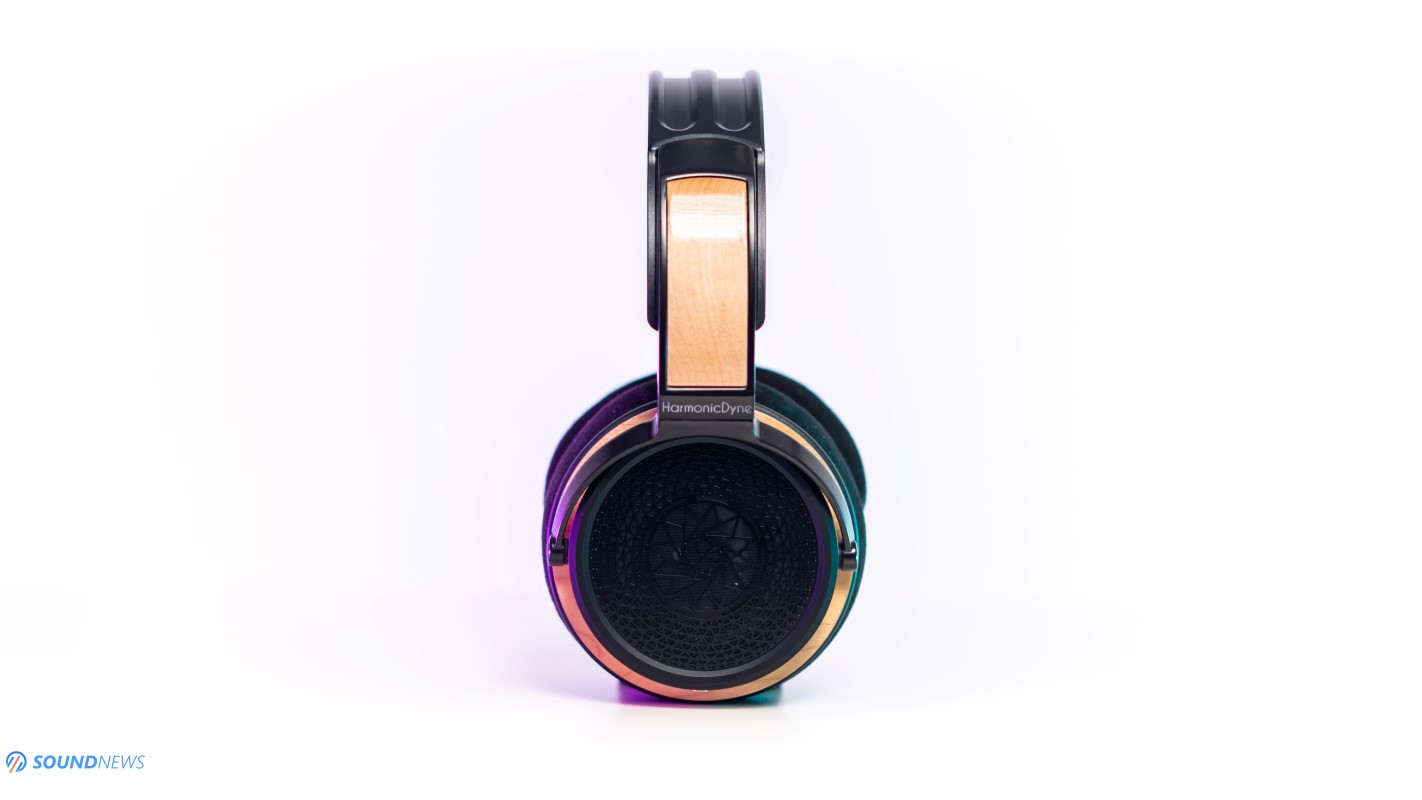
Build Quality & Looks
We are getting a very similar build quality to their predecessor, exchanging their silver motif with a matte black one. Poseidon looks stealthier, attracting less suspicious eyes and spots a different grille design. Poseidon has a larger earcup opening and you can actually see the driver assembly if you look closely and I expect them sounding slightly bigger on all axes. There is some plastic on top of the headband and the rest is made out of stainless-steel and maple wood. Their weight remained the same, at 380 grams, Poseidon is on the heavier side of things, but while holding it, it gives an impression of a well-made product. It can put to shame some headphones found in the same price bracket and if you hurry up and get them at the super-early bird price, I don’t think there is a headphone that can compete with them. I wish the wooden surface wouldn’t use a lacquer finish, except for that, there isn’t much to complain build-quality wise.
Their sliding headband is rudimentary and quite simple, you just pull one cup and adjust it to your head size. It looks sleek, uses a slim profile and there is some soft padding that will put little to no pressure on top of your head. The earcup holders are made out of stainless-steel, filling them with some kind of foam, just to keep the weight down as much as possible. Its earcups were carved from maple wood, which seem durable enough, plus it has good acoustic properties. There are several headphone manufacturers that are using this wood type (Kennerton Audio and ZMF are coming to mind) and I’m pretty sure these should resist some use and abuse at my battle-station in the company of several headphone amplifiers.
HarmonicDyne went with a 100% symmetrical design which I already encountered multiple times. Erzetich-Audio, OLLO Audio and Kennerton Audio have the same thinking behind their products and my co-designed Apos Caspian were also made this way. Their headphone connectors are directed to your shoulders, but considering their slim profile, I don’t think it would pose a problem for anyone. That wasn’t a problem for me, even with a third-party custom cable and mind you, I’m 1.91 m tall (6’ 3”). The headphone drivers are leaned towards the ears that should improve the directivity of the waveguides, à la Beyerdynamic T1 and T5 headphones.
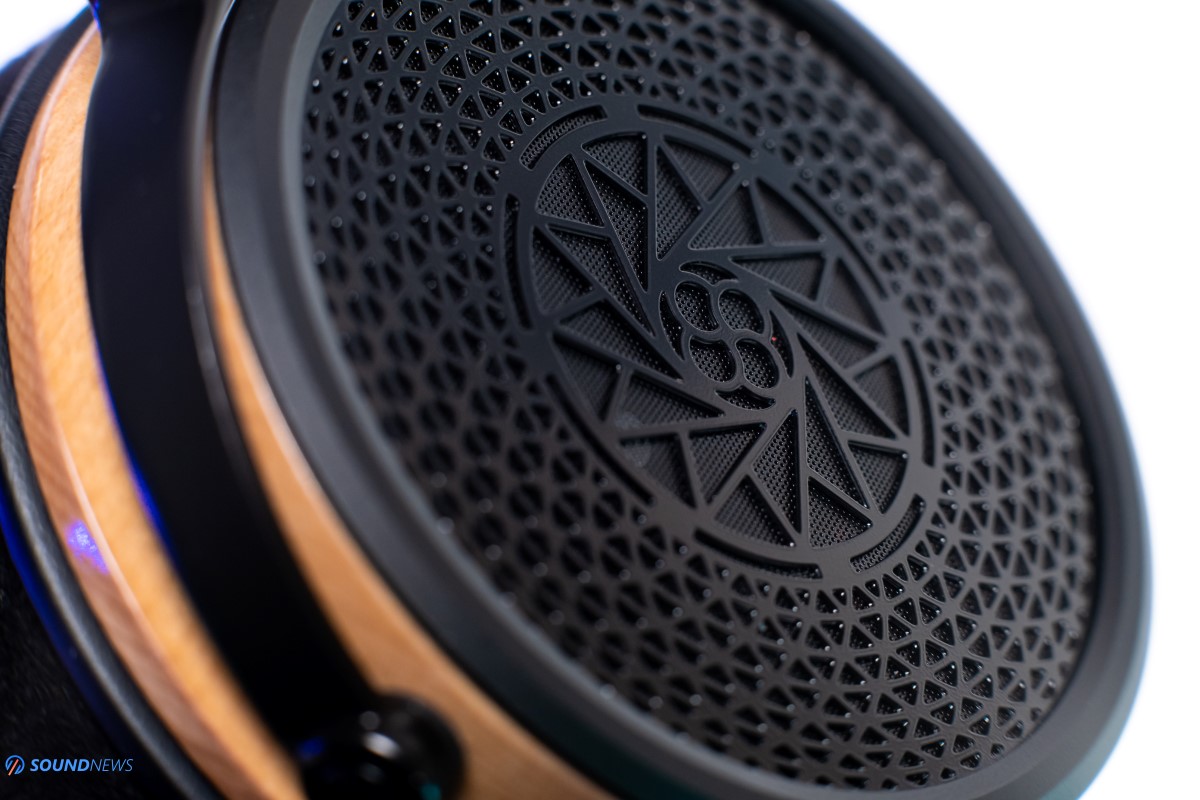
Comfort Level
The earpads are made out of suede fabric, padded with lots of memory foam. I find them soft and gentle enough to be used in long listening sessions. I find them bulkier to those of Hifiman and Sennheiser and thinner to those of Audeze, Kennerton and Erzetich. They fit around your head snugly and provide enough padding, putting just a little pressure around your ears. The pressure points are on top of your head and around your ears, anything else wouldn’t touch your head. In their stock form, there was a higher side pressure, but once I’ve adjusted them to my head size, everything went back to normal. I find them more comfortable to a Sennheiser HD600, comfier than any Audeze planars, but less so compared to a Meze 99 Classics and to any Hifiman headphones.
The earcups are moderately big, with an inner diameter of 90 mm and an outer one of 100 mm, these are neither big or small. Inside them a huge 50 mm driver will be playing music for you. These are marketed as over-ear open-back headphones and they indeed wrap my ears around nicely. These are slightly heavier than other headphones competing in the same price bracket, but in all seriousness, they feel pretty lightweight and comfortable, especially after listening to a 730-gram Audeze LCD-4 and Erzetich Phobos 2021 Edition all day long. I don’t mind their weight, as I’ve used them for a few hours a day, without feeling pain around my ears or on top of my head.
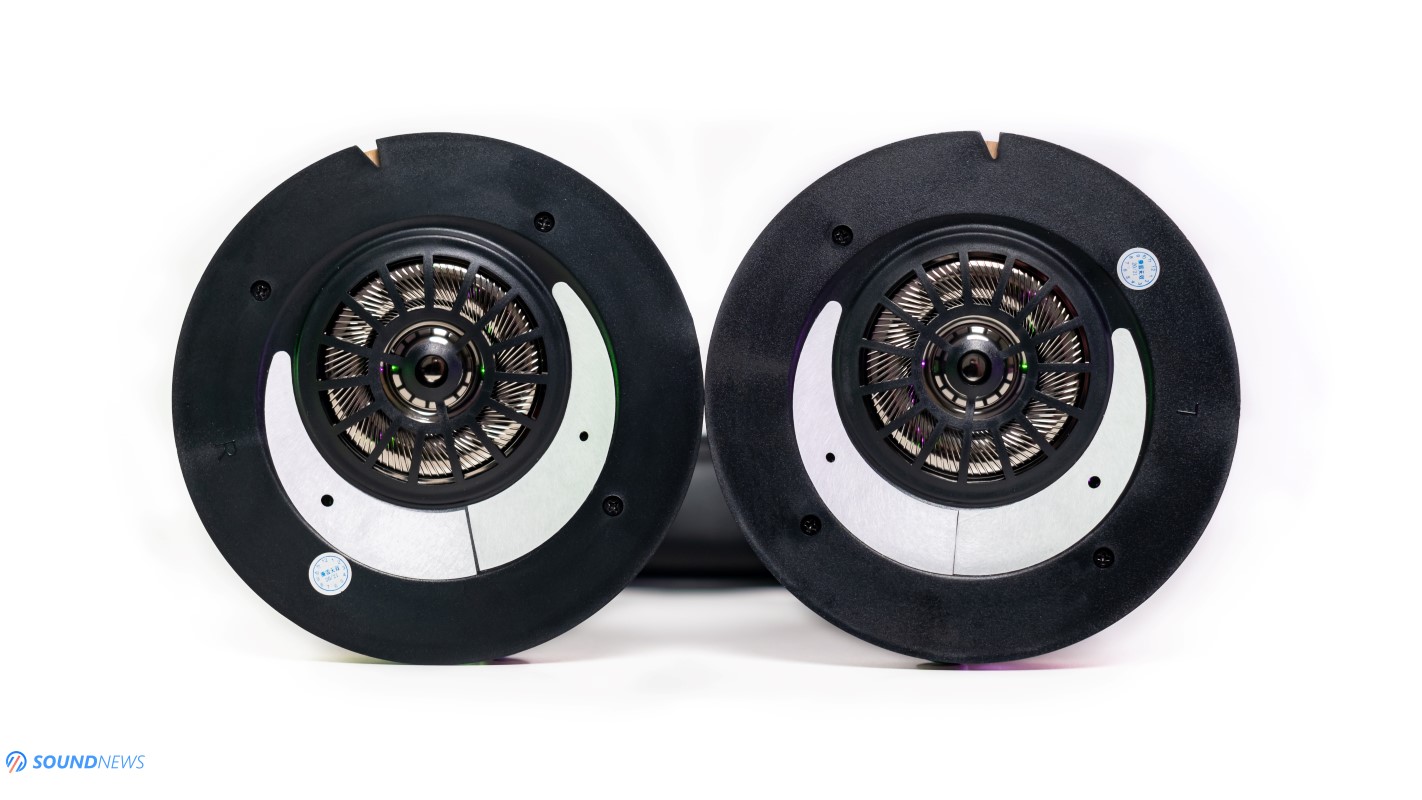
Tech Inside Them
HarmonicDyne is describing them as Wired Headphones in their user manual, but there is so much more going on the inside. We are dealing here with a big 50 mm dynamic driver that uses a pure nickel diaphragm. While beryllium was hailed as the king of diaphragm materials in the past, the molecular composition of nickel proves to be much superior, ultimately improving the sound propagation. Having four times the density and more than double the tensile strength of beryllium, purified nickel is a much stiffer diaphragm material, achieving greater clarity and articulation, while toning down distortions in the lower frequencies. Most nickel-based drivers used in audio products are nickel-alloys, being mixed together with lower-grade metals, greatly reducing production costs. Poseidon utilizes only the purest laboratory-grade nickel, producing an extremely well controlled frequency response with unparalleled technical performance.
Poseidon has an impedance of 64 Ohms and a sensitivity of 100 db per 1mW of power, suggesting that you drive them with portable devices such as small USB dongles, Bluetooth receivers, portable DAC/Amps or DAPs. It uses 3.5 mm connectors, so you could easily use your Hifiman / Meze / Kennerton and OLLO Audio cables if you please. It’s an open-back headphone, leaking a decent amount of sound outside its cups, so it should be used mostly at your listening battle-stations.
Unfortunately, I don’t know much about the driver thickness, about its voice coil, about its magnets and their strength so I will pause here and will start hitting some eardrums!
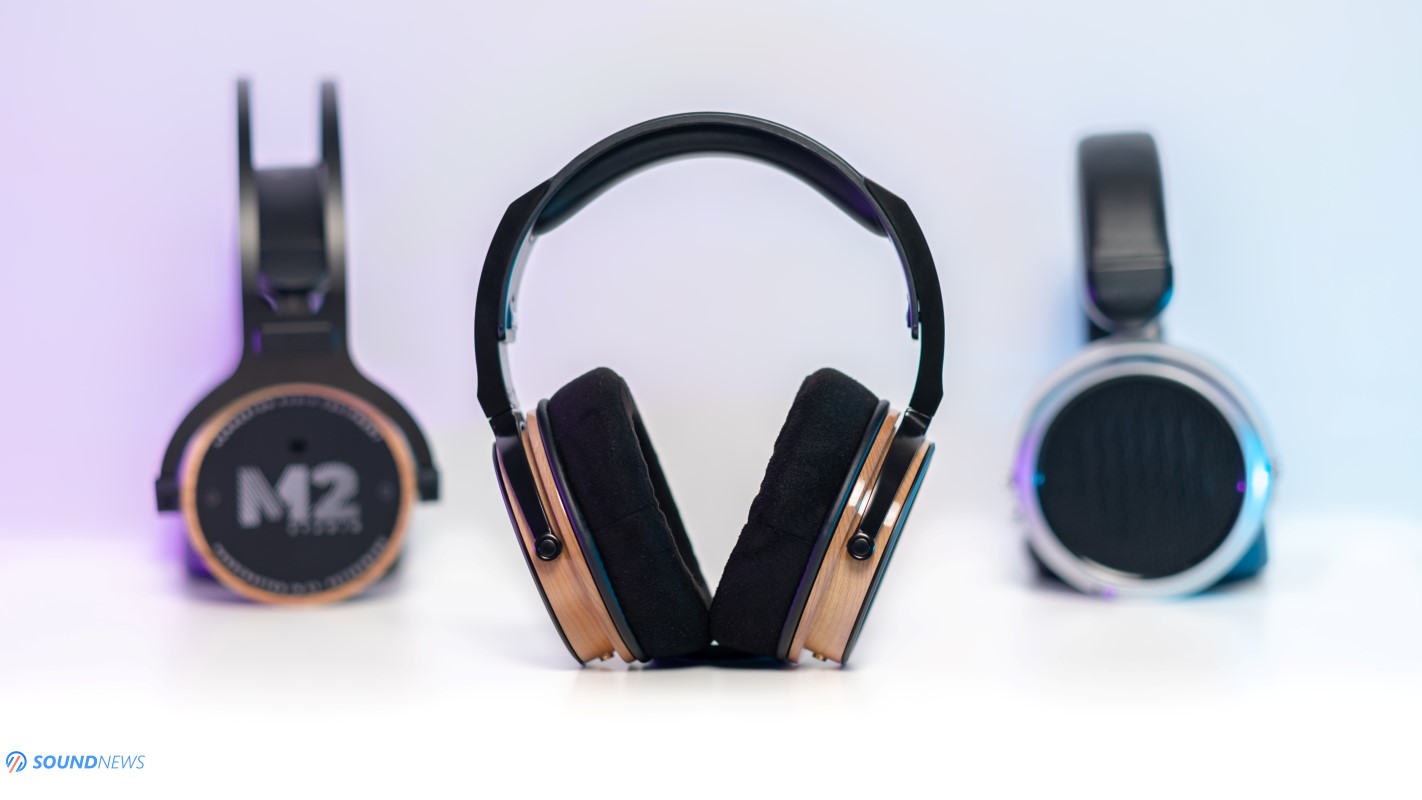
Sound Performance.
I. Preliminary Impressions
It was very clear from the start that I’m dealing with a resolving headphone that could unearth a substantial amount of micro-details from my music, while sounding extremely fast, decaying naturally and providing more oomph in the mid-bass compared to its predecessor. While I find them nimble and agile in the sub-bass, most of the energy is being delivered in the mid-bass, creating an engaging and colored sound signature. Their predecessor had a strong V-Shaped sound tuning, focusing mostly on mid-bass and treble delivery. Poseidon on the other hand is more balanced sounding, going with a safer, mid-centric tuning, discarding a lot of brightness and listening fatigue of its predecessor.
Zeus wasn’t exactly bright and harsh sounding to me, but with achromatic and linear-sounding headphone setups, those could pose a slight problem in the long run. When I’m reviewing headphones, I would always use a linear sounding DAC and headphone amplifier, so I could better feel the sound signature of the headphone that is being attached to them. I will be measuring them later on, but even without any of that, it is clear that HarmonicDyne wanted a more balanced sounding headphone, that doesn’t rise the upper treble as much as Zeus did.
By far, the biggest surprise for me was how coherent, fast and impactful they sounded, considering that I’m dealing with a dynamic driver headphone. That nickel diaphragm is indeed a speedy sounding driver, that can keep up with the most demanding tracks. If you are into technical electronica, modern pop, rock and metal, then Poseidon got you fully covered. Generally speaking, dynamic drivers can’t reach the speed of well-made planar or electrostatic headphones, but HarmonicDyne put their bright minds to work, releasing a speedy sounding headphone that wouldn’t kill your wallet for good.
Another clear improvement over the Zeus was experiencing my music at a bigger scale, as there was more width and a better depth. I presume a bigger earcup opening in the center, pushed more air outside its cups, that subsequently improved the medium-sized soundstage. It wasn’t grand, wide and open by any means, but it was neither closed-in and personal, as it was the case with its predecessor.
Lastly, Poseidon felt as a detail-oriented headphone, revealing a substantial amount of information even compared to pricier headphones as Sennheiser HD650 for example. Listening to albums that I know for a lifetime, strengthened my initial impressions that Poseidon is a ruthless headphone, showing all the good and bad happening with downstream equipment. They scaled incredibly well on a better performing DAC and headphone amplifier, sounding considerably clearer, faster and more impactful in a reference setup versus a mid-level stack or portable device. With transistor-based Class-A amplifiers there was even more air put in the between the notes, making them even bigger sounding, while adding more presence down-low and in the midrange area.
Last but not least, the slight shoutiness of its predecessor, associated with a dip in the upper midrange and lower treble is still present, hurting a little the performance of higher pitched acoustic instruments, stripping down their intensity, textures and density. All in all, they calmed down the upper treble, they added a bit more energy in the mid-bass, there is a bigger scale, a better depth and a higher resolution compared to their predecessor, scoring more points when it comes to technicalities.
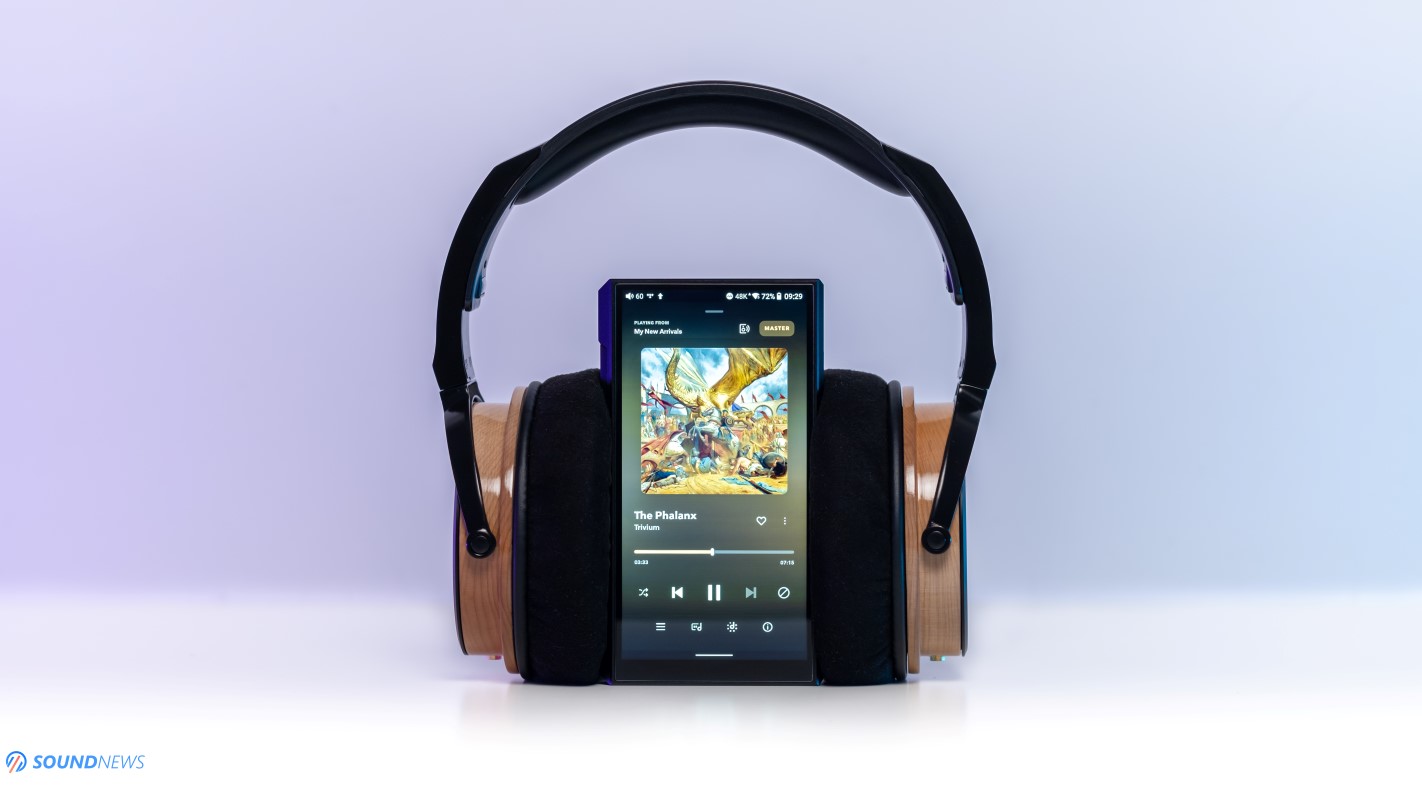
II. Power Requirements & Amp Pairings
Poseidon has a similar impedance and sensitivity to its predecessor, so I’ll briefly touch base on this subject. According to REW 5.19 software and to the microphones inside the MiniDSP EARS system, power requirements are by about ~12 dB higher compared to a Kennerton Gjallarhorn, resulting in a sensitivity of around ~100 dB. Since these are as loud as Kennerton Vali, their sensitivity of 100 dB per 1mW of power mentioned in the manual is very accurate, being in line with plenty of entry level planar-magnetic headphones as Audeze LCD-1 and Hifiman HE400SE.
Poseidon sounded just okay out of my smartphone and considerably better out of a Microsoft Surface 7 Pro. Portable dongles worked even nicer as there were more details and a blacker background. I Particularly enjoyed their pairing with a tiny Shanling UA2 that made them impactful and considerably more engaging in the long run. Bluetooth gizmos as Qudelix 5K and FiiO BTR5 sounded more or less the same, providing enough current and voltage gain for a higher SPL action. Obviously when I moved to affordable desktop setups as SMSL SU-8S and SH-8S or Topping E50 and L50, things improved drastically, as I felt a higher dynamic range and a better control of their drivers, especially with fast and impactful tunes.
The absolute best pairings were made with transistor-based Class-A amplifiers that infused more warmth in the upper midrange, while further smoothing out the upper treble, so I could use them in prolonged listening sessions without getting listening fatigue. Any of the Flux Lab Acoustics and Burson Audio amplifiers should elevate their performance to the next level, dealing with their minor flaws, while adding more air and flow in between the notes.
On super tight budgets, I would pair these with something like a Topping E30 and L30 combo, with a JDS Labs Atom DAC+ and AMP+ stack or with a Schiity Modi and Vali/Magnius. As a step-up, SMSL SU-9 with SH-9 or Topping E50 with L50 should offer an audible improvement. If you want only the best, look no further to Class-A amplifiers like those I’ve mentioned before.
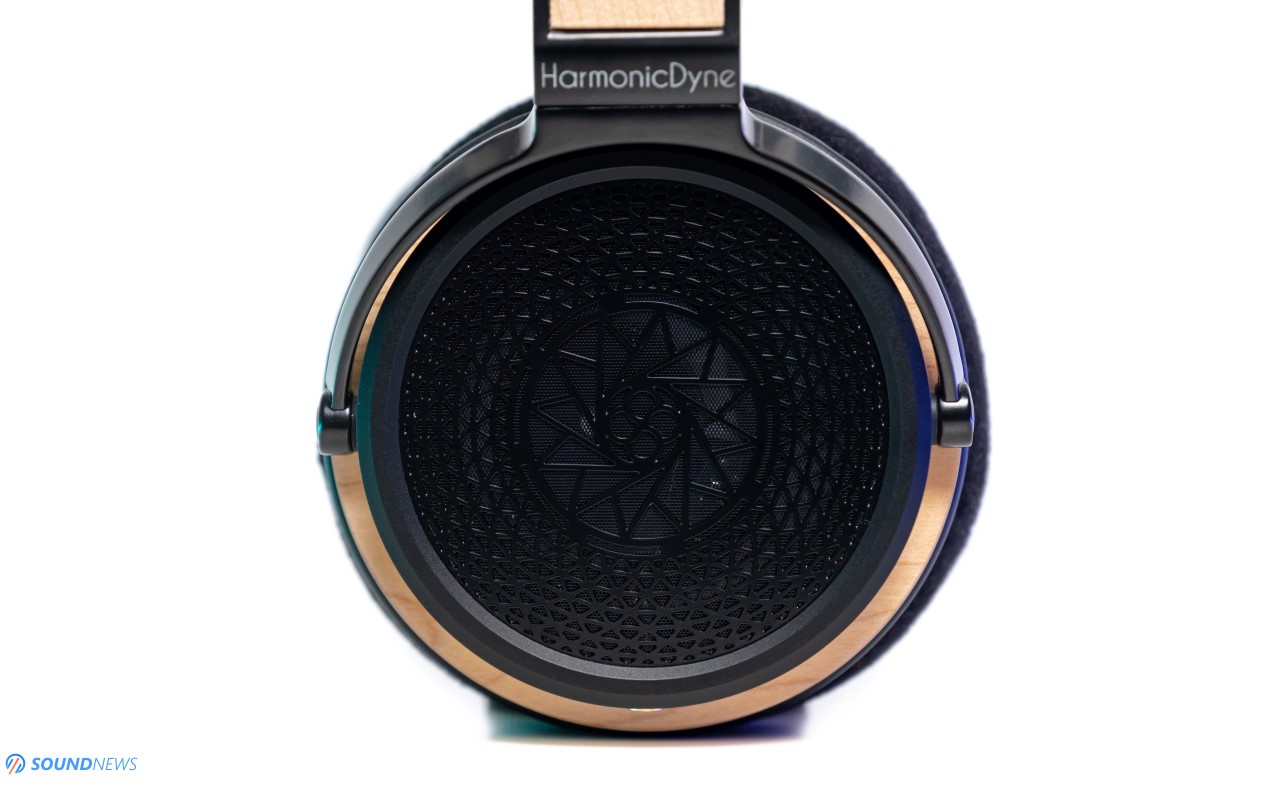
III. Transient Response
Poseidon are without a doubt technical sounding and most of the magic starts in here, with the transient response. I might complain a little bit about their low-end extension below 50 Hz, but when it comes to speed, they will easily keep up with lightning-fast tracks. When my mood is low and coffee doesn’t do its thing, a healthy dose of electronica mixed with anything else, always does the trick for me. Spirituality and Distortion by Igorrr (Qobuz / Tidal) is such an incredibly technical, weird, unique and grotesque sounding album that every single time I’m listening to it, different thoughts are passing through my mind. For the love of Odin, don’t listen to this album on your loudspeakers, but please give it a try with your headphones. Once Very Noise and Camel Dancefloor started playing, I knew that I’m dealing with an extremely fast and dynamic sounding headphone. It goes in and out in fractions of a second, double-drums didn’t pose a problem, fast ‘n’ funky beats punched my eardrums like punching bags and I’ve never felt them pressing the brakes when it comes to dynamics.
Due to a mild-rise of the mid-bass, Poseidon are not only going extremely fast, decaying the notes in the same way, but they also move a substantial amount of air in an instant, proving enough slam and impact even for bass-heads. Zeus were already quite amazing in this department, but Poseidon will be sending those bass notes in waves, kicking your eardrums one after the other, delivering just enough bass slam impressing a transient response nut as myself. While there are several remarkable sounding planar-magnetic headphones that are outperforming the Poseidon as far as transients go, all those are going way past 1 kilo-buck, making the Poseidon a natural alternative at a much lower price point.
Transient response was impressive on their predecessors, but its even better on the Poseidon. Frankly, it’s their best trait yet and I’m curious how there will measure when it comes to decay and FR.
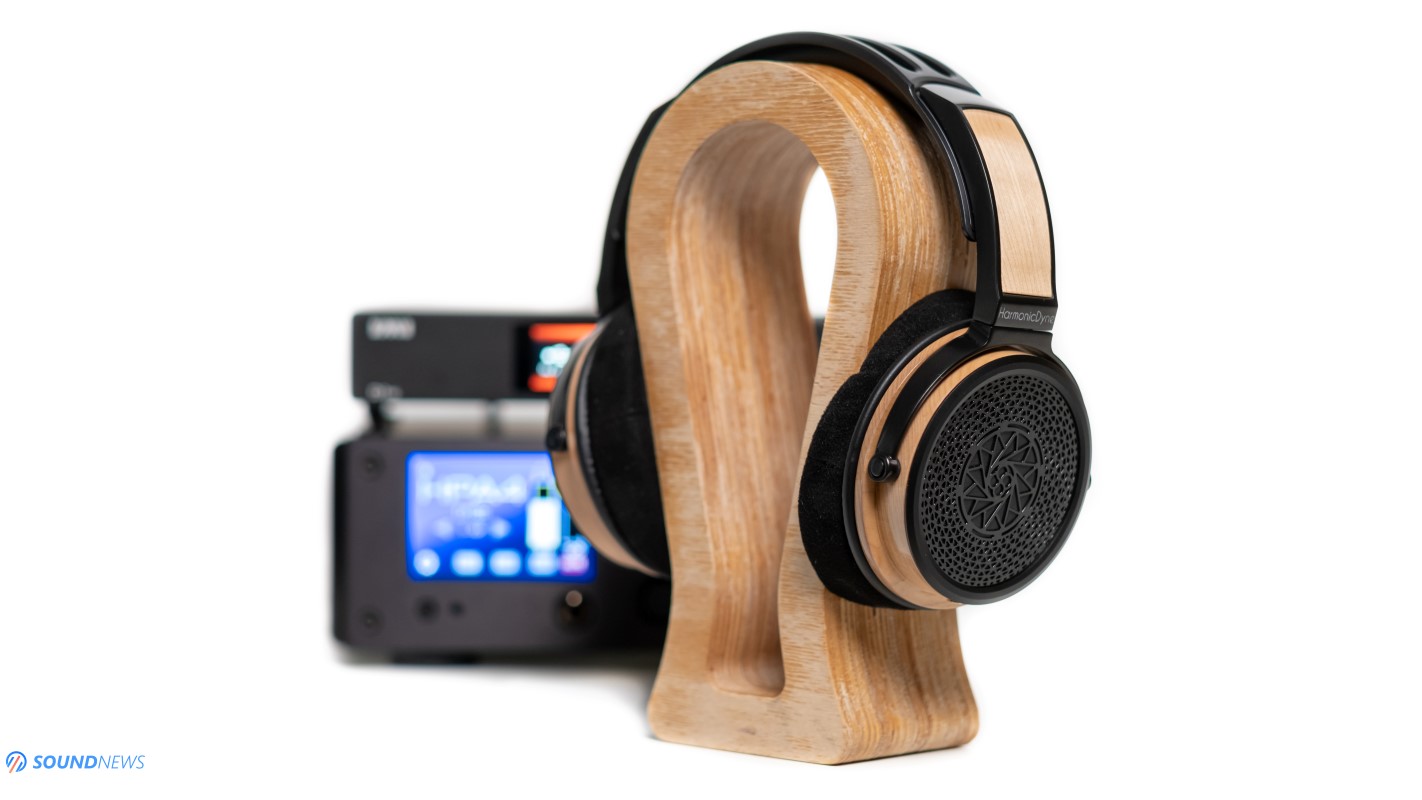
IV. Detail Retrieval & Transparency
Going from a composite driver on their first-born, to Beryllium coated and then to a pure Nickel diaphragm, improved their pistonic movement and speed of delivery, but it improved the most their resolving abilities, by offering more details on the micro scale for the listener. Maybe their acoustically transparent grilles did also make a positive change in here, but clearly Poseidon appears as a highly resolving headphone to me, trying to impress the most with its transients, detail retrieval and then with everything else. Making highly detailed planar drivers isn’t that difficult anymore, just take a look at all the newest affordable Hifiman planars, but when it comes to dynamic drivers, people always paid a premium for a higher resolving power. A friend loaned me a pair of Sennheiser HD600 for a few days and while I really enjoy their tuning with acoustic and instrumental music, Poseidon provided considerably more nuances and texture anywhere in the FR. There was more information across full frequency response and if you really like dwelling deep in your tracks, searching for Lilliputian details, then Poseidon will easily do that without breaking the bank.
On top of that, these can scale impressively with a nicer headphone setup. While they sounded good out of a SMSL SU-8S and SH-8S combo, there were more details and more air was traveling around with a SMSL D1SE DAC on top of a Benchmark HPA4, that were squeezing the last drop of information out of them. With this wombo-combo, I found them transparent and clean sounding, looking deeper into my tracks, without straining myself too much. I find them impressive in the most sensitive part of our hearing (5-7 kHz), that added a welcomed layer of information on top, making them work as a magnifying glass for my music.
With audiophile-proof music, they were able to direct my attention towards tiny details like small chat in the auditorium, feet movements and on air traveling freely around the room. All that came naturally towards me and that makes them quite special in here.

V. Soundstage & Depth
As you all know, headphone drivers are pushing air in both directions, to their front and behind them. All acoustic waves that are being pushed behind the driver could pose a serious issue with closed-back and semi-open headphones, but it’s a much lesser concern with fully open-back headphones. Although, not all open-back headphones are made the same, you’ll never find them exactly as open and acoustically transparent. For the most open sound, check the newest Hifiman creations that use an impressively engineered Shade System.
When a light source is shining on Poseidon grilles, I can see the actual driver assembly and everything that is happening in there. That open area is somewhat bigger to that of Helios and Zeus, meaning that sound waves are traveling easier in and out, with less energy remaining inside their cups and that always leads to a lower distortion and…to a much bigger sound. I have tried different earcup openings when Apos Caspian was going through its design phase and of course a bigger opening sounding the best for me, considerably bigger on all axes and we went with that design.
While Poseidon cannot be described as enveloping or incredibly big and wide sounding on all axes, they are bigger sounding to its predecessors, which I’ve called sounding more as semi-open headphones. In this regard, Poseidon is more impressive, outperforming the likes of OLLO S4X, Sennheiser HD6XX family of headphones and even much pricier units as Fostex TH909. I’m reminding you that I’m describing some fast-moving drivers, so forget about muddiness or bloat that again improves a little the final imaging and pin-point location of the notes. It wasn’t a challenge hearing a few notes closer to me and others buried deep in the mix, traveling a longer distance before reaching my eardrums. Focusing on anything in particular was an easy-peasy job, so again their imaging and depth were quite good.
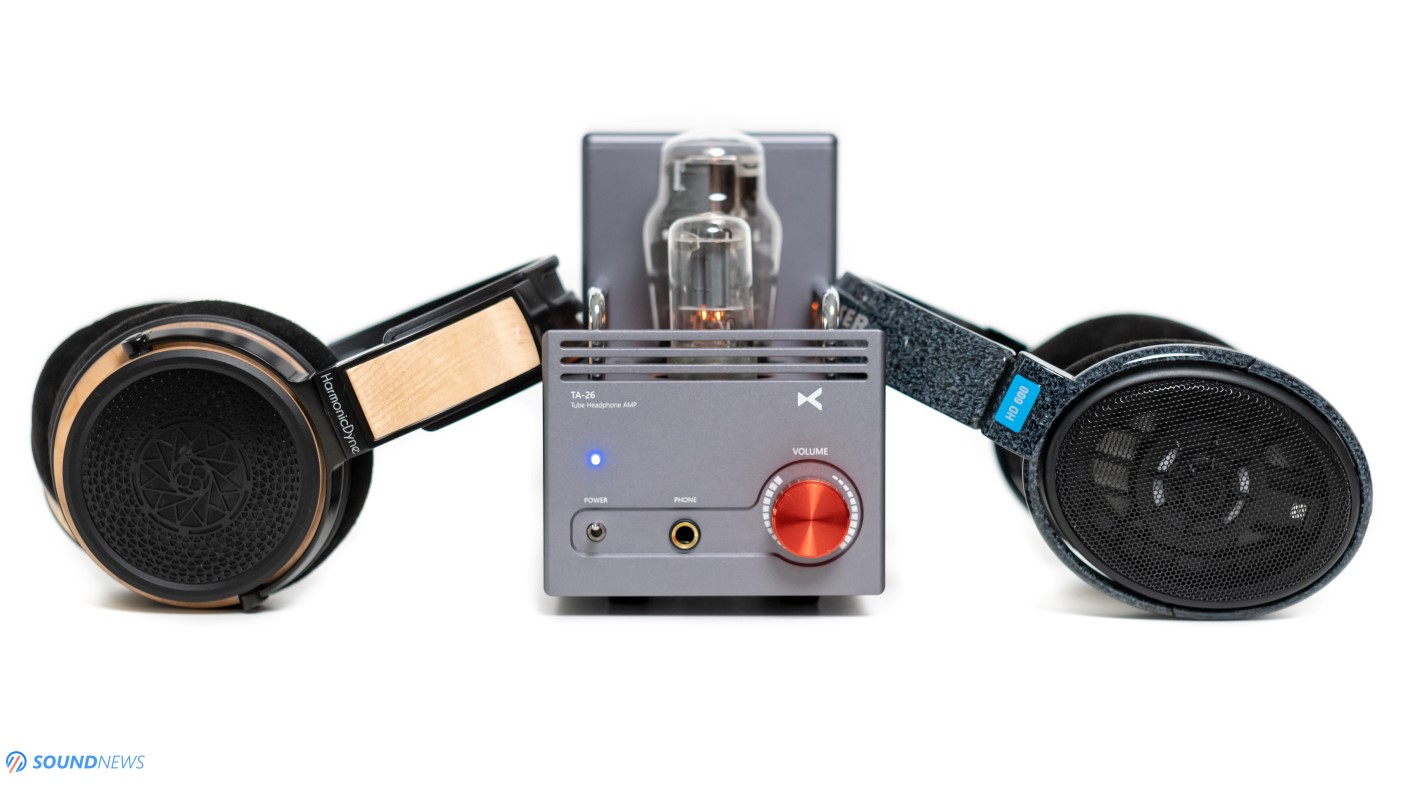
VI. Frequency Response
A. Bass
While they have some mighty impressive drivers in that housing, their suede pads are slightly altering their low-end delivery. To be more specific, below 60 Hz there is a gentle roll-off that slashes the sub-bass region by around 10 to 15 dB. If I’m applying a gentle pressure on the earcups, plenty of sub-bass energy goes back to normal, making them again impactful and energetic sounding. When I’ve replaced them with leather earpads from a pair of Kennerton, guess what happened? Its sub-bass delivery became straight as a line, sounding impressive from 20 Hz to 200 Hz, delivering as much bass information as a bass-head would ever need. Apart from that, they have a speedy bass performance regardless of the earpads being used, never lingering too much, always running and hitting my eardrums with an incredible force. I find them clean and quite transparent, so we are talking about a high-quality type of bass. Going up to mid-bass territory, things are getting a little out of hand. There is more energy in the mid-bass than anywhere else in the frequency response and as you can imagine, that makes them quite fun and weighty. That trick added some warmth and a lot of presence in the bass, lifting the mood of the listener. I don’t know if it was on purpose, but it seems that Poseidon is gently following the Harman curve.
B. Midrange
Its midrange performance can be described as quite linear and clean sounding. There is a gentle slope happening in the 1 to 2 kHz area, but it isn’t worrisome, taking down some energy from higher pitched female voices and removing some presence from string-based instruments. While I wouldn’t call them as incredibly natural or soul-grabbing, there is enough warmth and presence to shoo away thinness and listening fatigue. Past 3 kHz things are starting to roll-off at a faster pace, giving an impression of shoutiness, as few sounds lost their weight and intensity. Everything else happening in that region was toned down by a few notches. Poseidon felt by a hair drier to the sound of planar magnetic headphones and to the likes of Sennheiser HD600 and Meze headphones. Nonetheless, voices still carried emotions, I still enjoyed my blues and jazz collection even out of a super-linear and transparent sounding headphone setup as Matrix Audio Element X powering the Benchmark HPA4. There is still some warmth, liquidity and presence in there, but not as much to impress a die-hard midrange addict. This is a less impressive part in the frequency response and I remember that Zeus performed pretty much the same.
C. Treble
On very rare occasions its predecessor could sound a little harsh and brittle, especially with treble intensive music as rock and metal. Since those are taking a big portion of my daily audiophile diet, as you can guess, Zeus weren’t well-regarded with such musical genres. HarmonicDyne took that feedback and tuned their newest creation slightly different, dropping around 8 dB from the most sensitive part of our hearing. Some headphone measurements will follow shortly, but even without them, it was clear that I am dealing with a clean and detailed treble, that doesn’t go overboard to the bright camp. While there is a lot of texture and plenty of information appearing out of thin air in the upper-treble, I could listen to rock all day long without feeling uneasy and wear out. Going past top-octave, Poseidon starts rolling-off plenty of energy, so that cymbals crashes and tambourines would never scratch my timpani. Overall, they had plenty of zing and bite, they had texture and detail, but they didn’t offer brightness, never raising glare to dangerous levels. Kennerton leather earpads, elevated their treble performance to a point of become worrisome, maybe some perforated earpads could provide the best of both words (bass impact and relaxed top-end), but I don’t have such earpads to fit their shape.
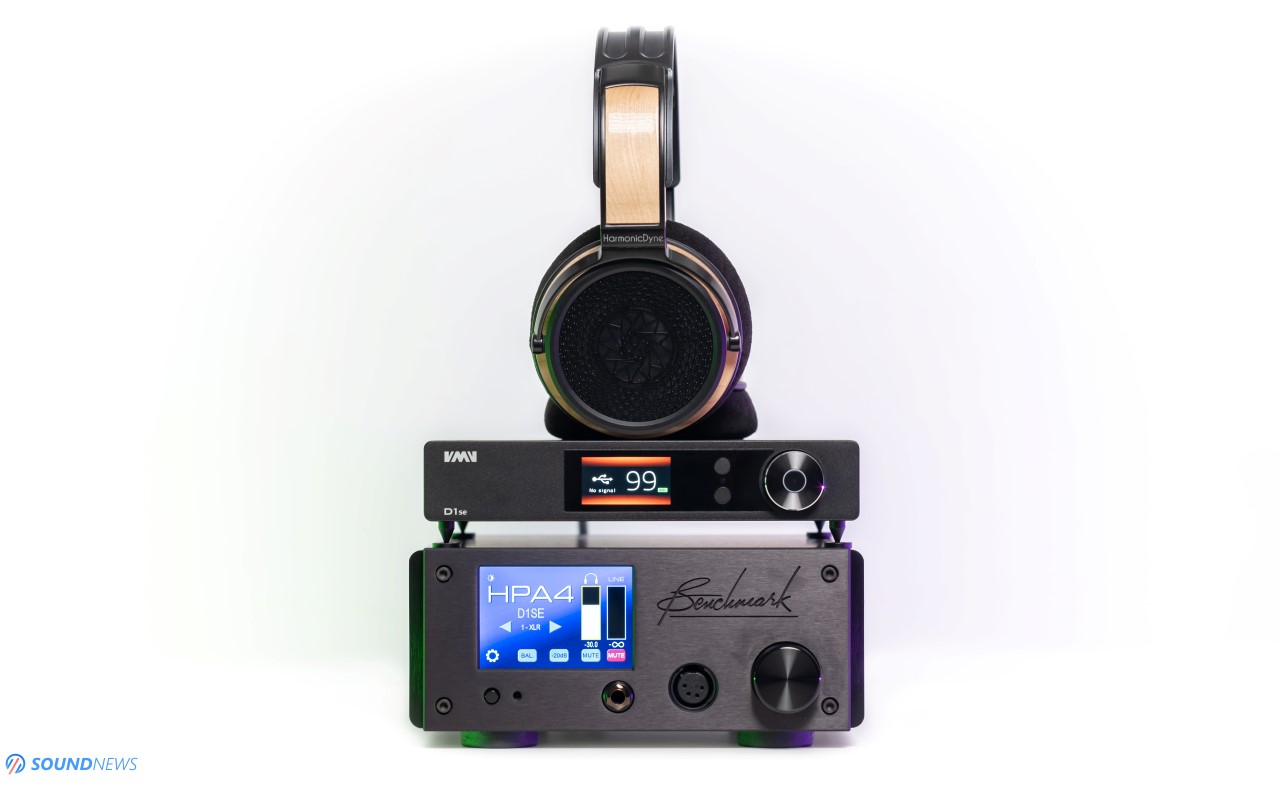
VII. Headphone Measurements
Alright folks, after offering my full-blown subjective opinion, it’s time putting them under a magnifying glass. When it comes to measurements, I have the highest confidence in the Benchmark HPA4, as it is as linear as headphone amplifiers could ever be and I have resumed at using the Matrix Audio Element X as the main DAC for the job. The measurement rig used was the MiniDSP EARS calibrated with HPN (Original Headphone Compensation) files. Do note that MiniDSP EARS is not following IEC standards, meaning that my readings can’t be used as reference measurements or anything like that, I’m doing them only to get a general idea about their sound signature.
I have measured them several times, as finding the perfect spot on the test jig wasn’t that easy. No side-pressure was applied on the earcups, they stood still in their natural position and I’ve measured them several times before both channels were matched at less than 0.5 dB.
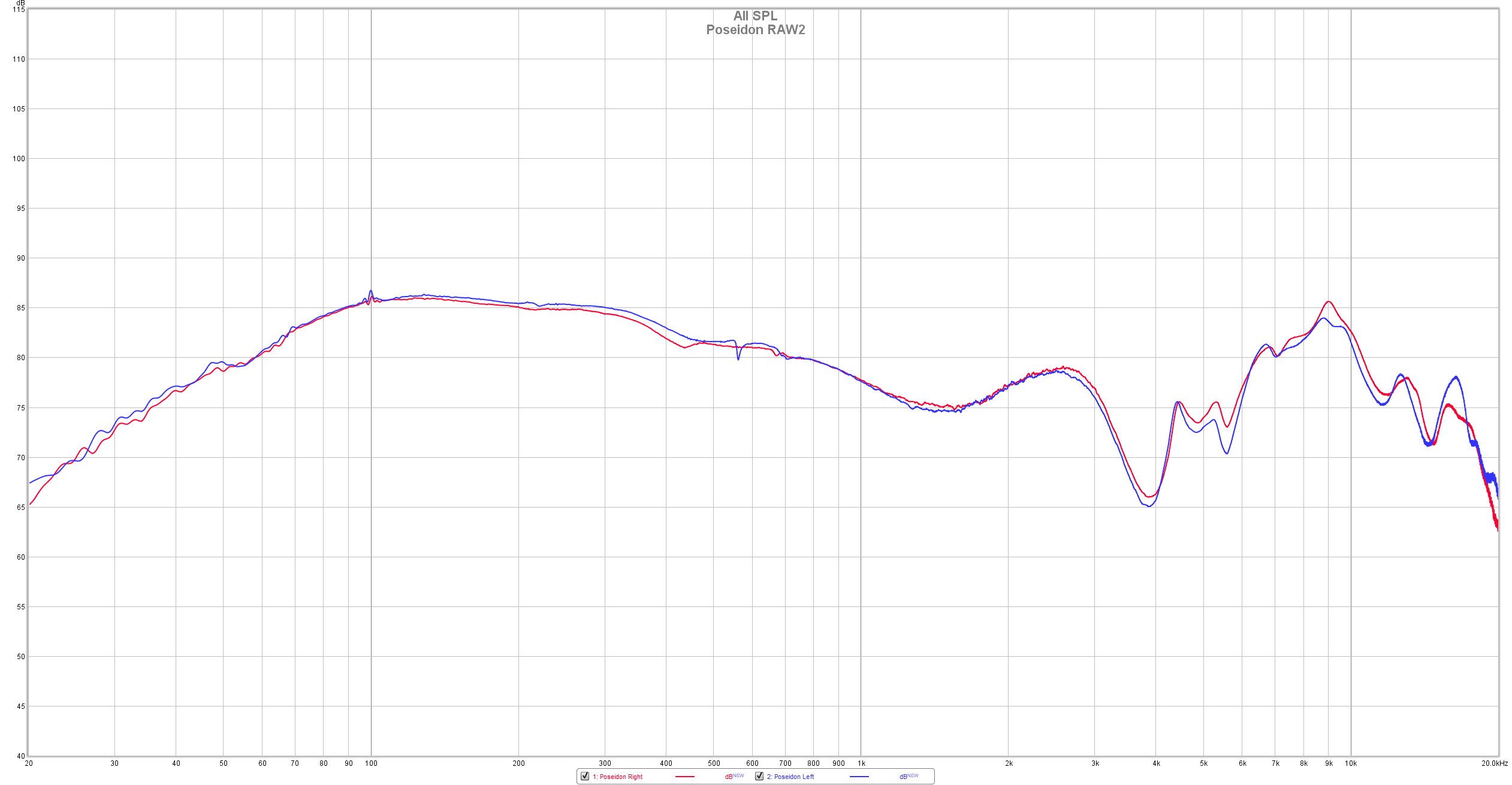
Take a look at their RAW graph without smoothing out the FR. First and foremost, I’m impressed by their close to perfect driver matching. Their slight deviation at 5 kHz and then past 15 kHz is negligible and I hope that HarmonicDyne will do the same with all their headphones.
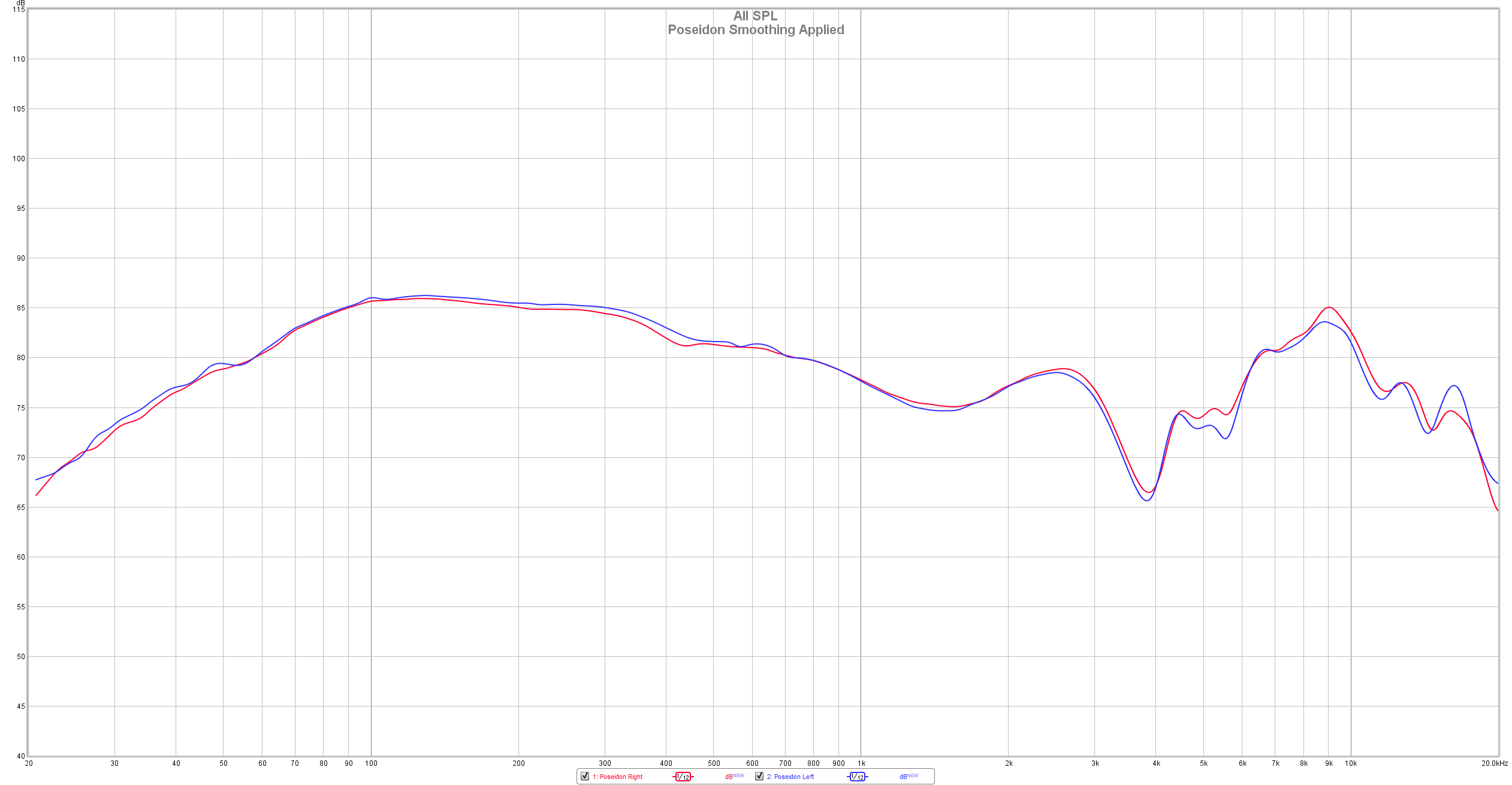
Applying a gentle 1/12 smoothing, I am getting this graph and as you can see, there is a slope in the sub-bass with its stock pads, mid-bass is a whole lot more powerful to a point of being elevated by a few dB. Midrange is mostly linear, but it sees a gentle slope until upper-midrange is hit with a serious roll-off that creates that shoutiness. Treble is way more relaxed to that of Zeus, especially in the most sensitive part of our hearing. There is some presence in the top octave that gives an impression of a detail-oriented headphone and then it roll-offs slowly past 14 kHz. All in all, it seems that Poseidon was tuned towards an enjoyable experience, in detriment of a linear frequency response.
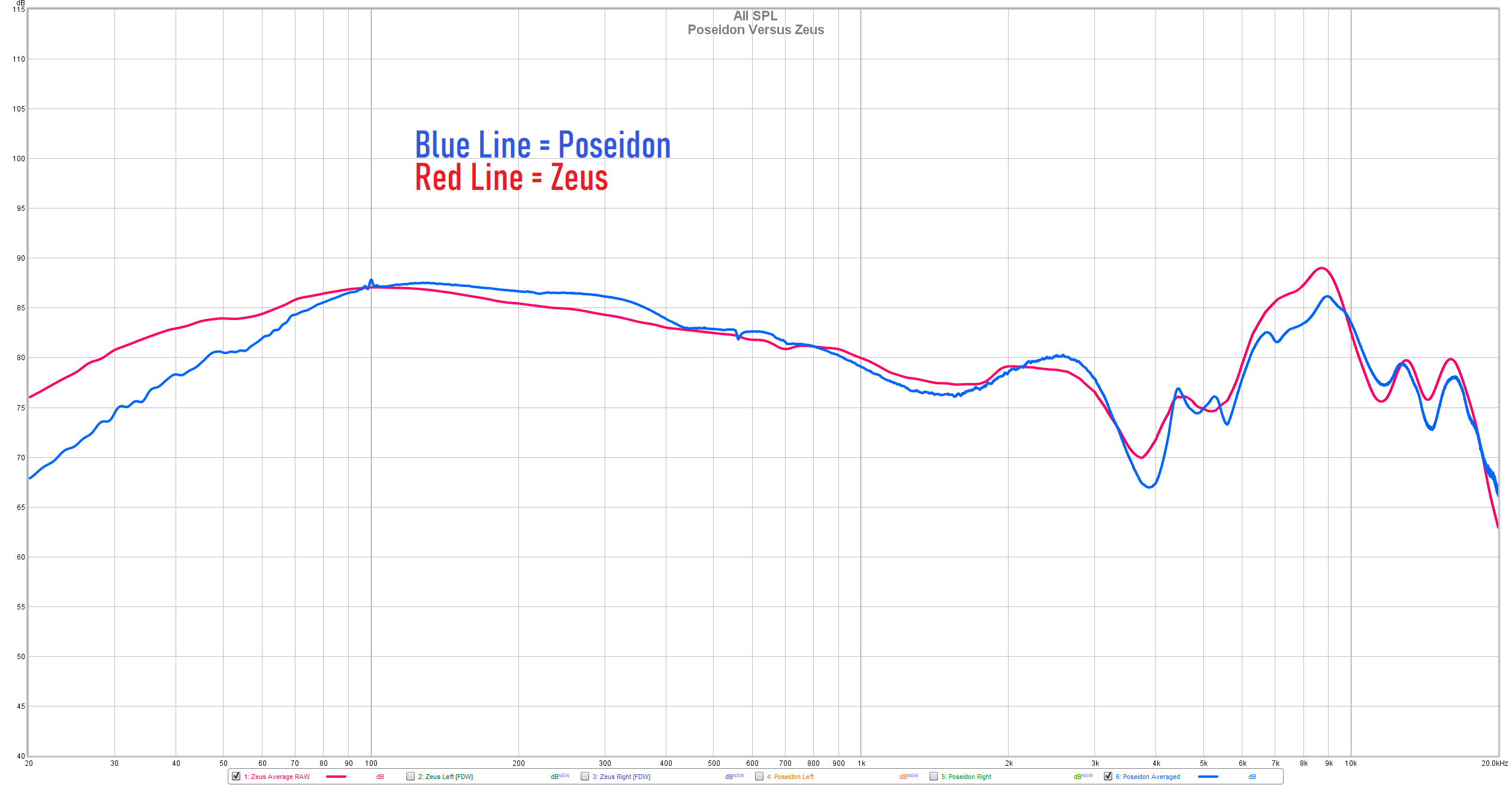
If you are curious how Poseidon are looking near their predecessor – Zeus, here’s a FR comparison between the two, without any smoothing applied. Notice the difference in the sub-bass and then in the upper treble. Brightness is more important, so in my opinion Poseidon looks like a more balanced headphone top to bottom.
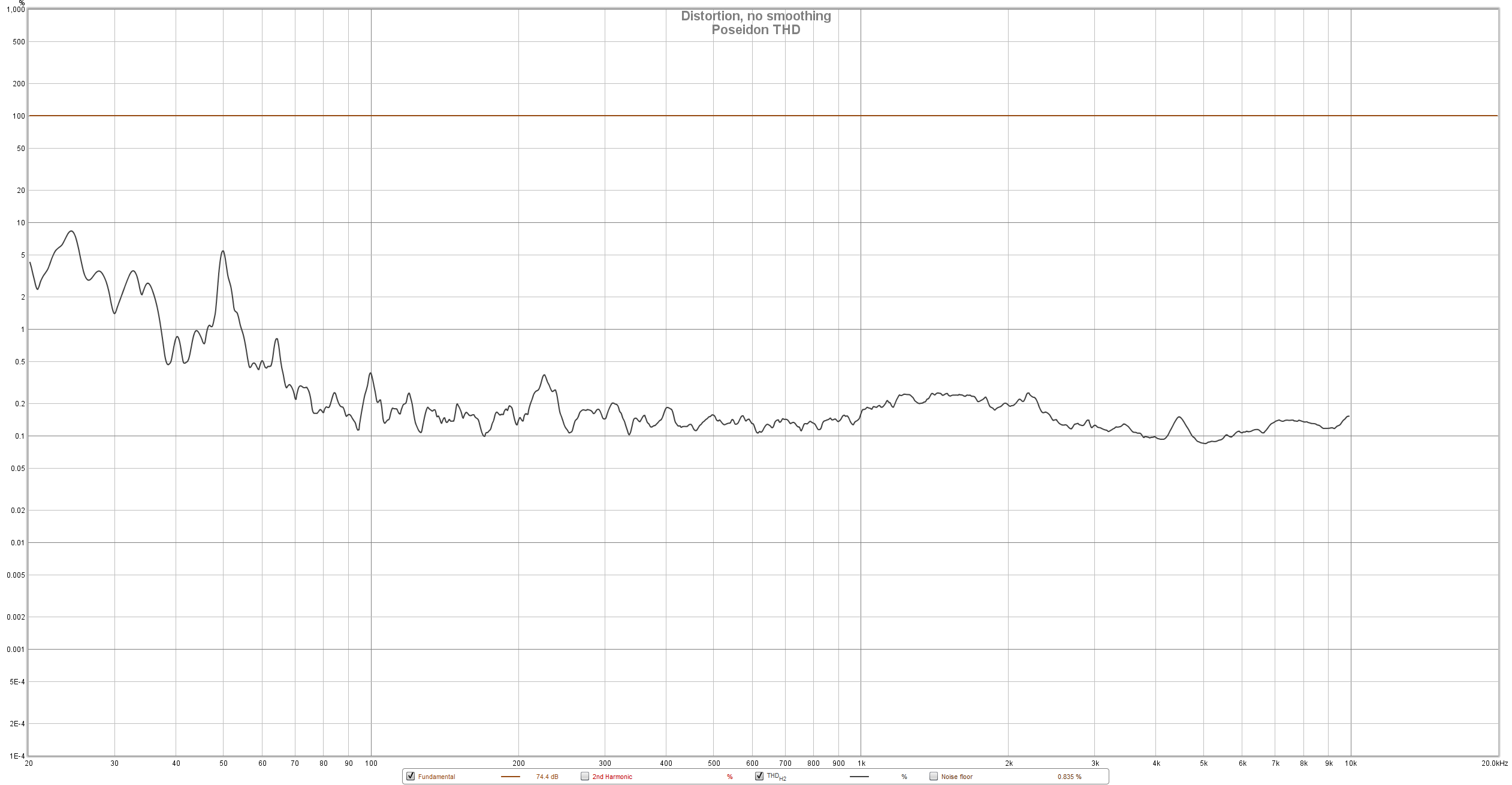
Considering that we are dealing with a dynamic driver, their THD reading is quite decent, but not impressive, especially in the sub-bass region, where it can reach 5%. Some pricier headphones could go much higher (Grado for example), so this is still a pretty good result.
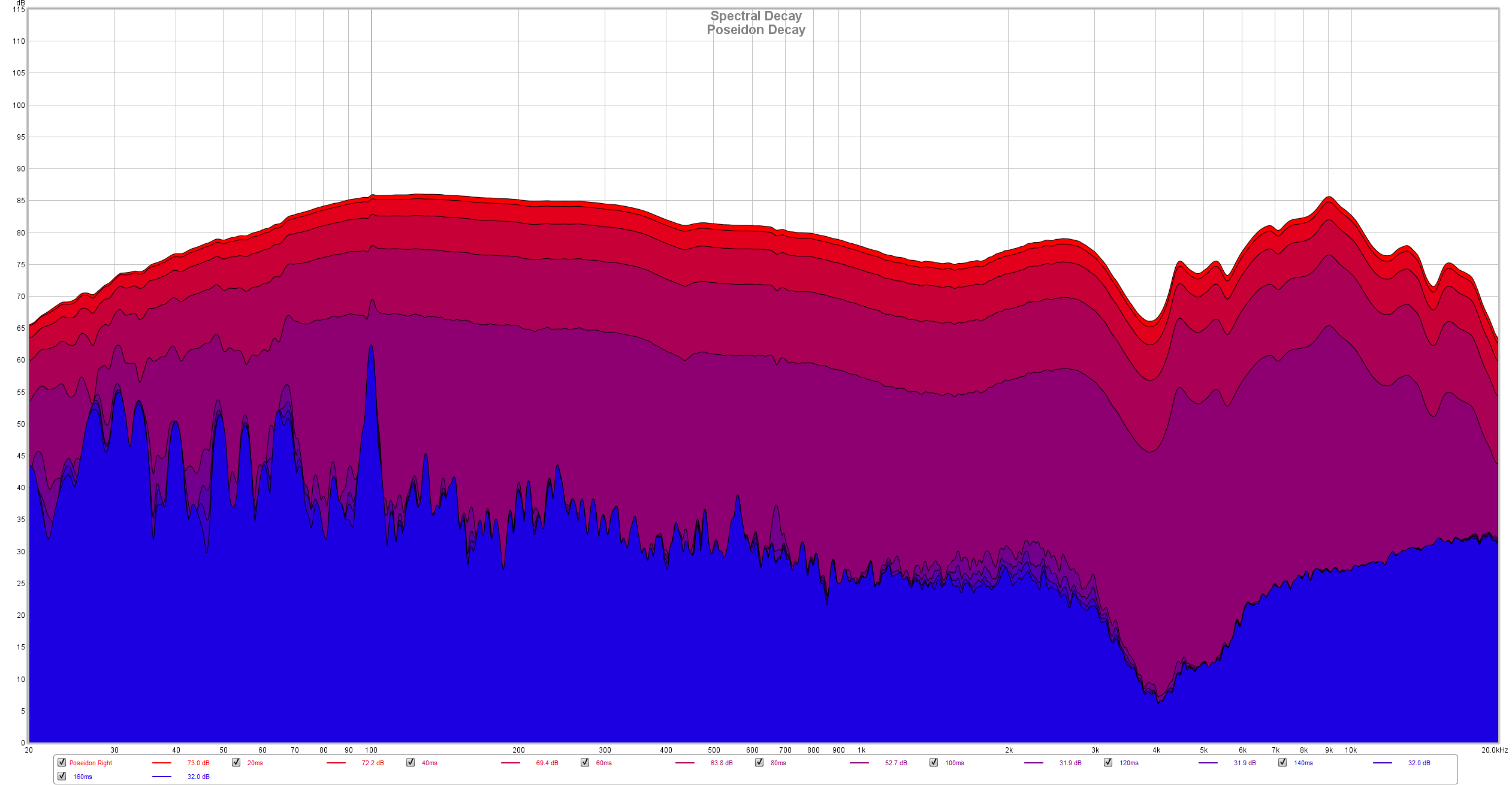
Spectral decay looks good, after sending a 300 Hz sweep tone at 84 dB, it drops to 32 dB after a short time frame of 160ms, strengthening my claims that this is a super-fast and impactful diaphragm. Sure, there are even faster sounding headphones out there, but probably not at this price point. Decay is impressive, easily rivaling even entry to mid-level planar-magnetic headphones.
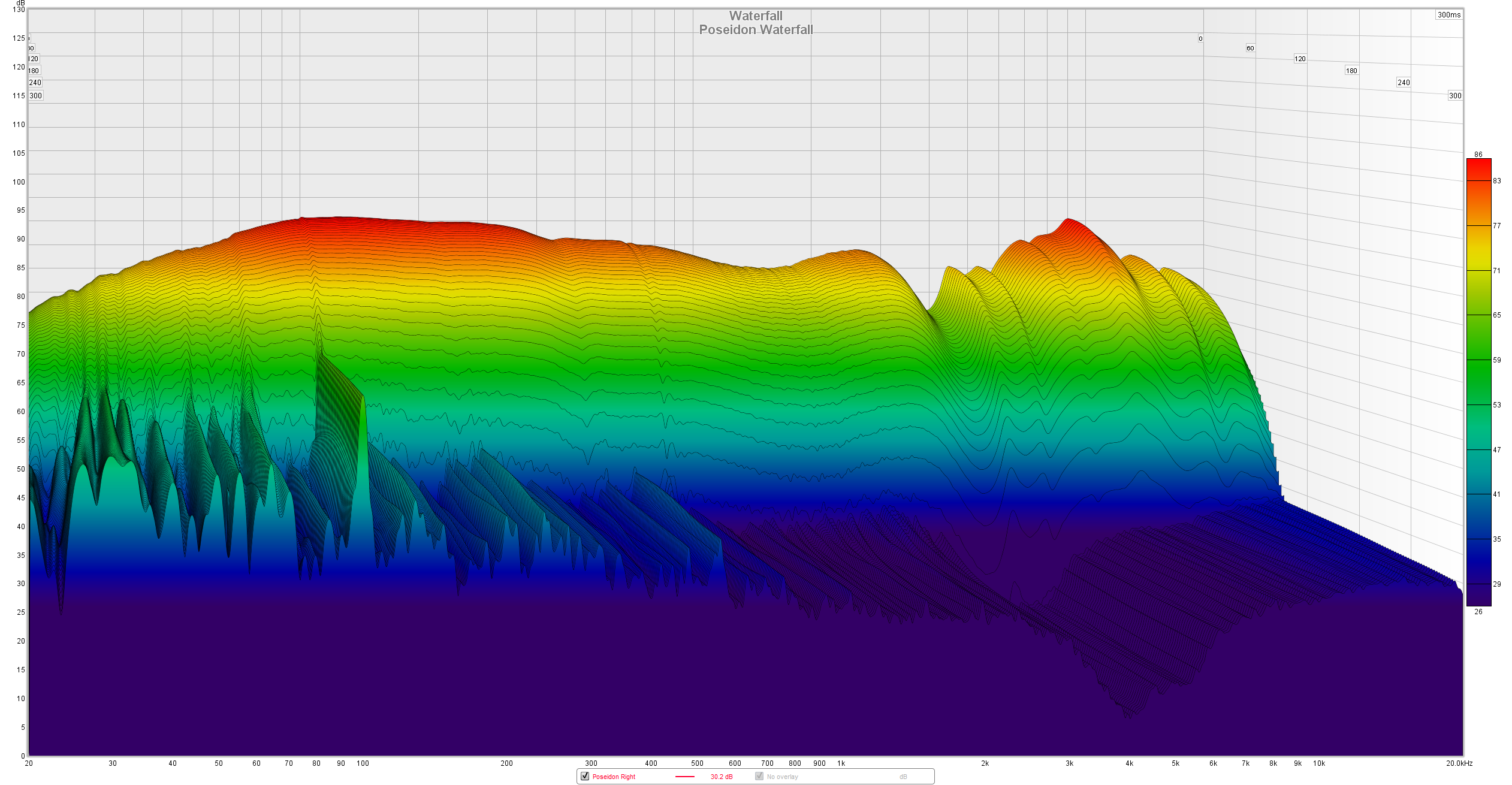
Waterfall combines the FR plot and decay into a single graph and you can clearly see the hot spots in the FR and the slower driver movement in the bass, but that’s normal behavior for open-backs.
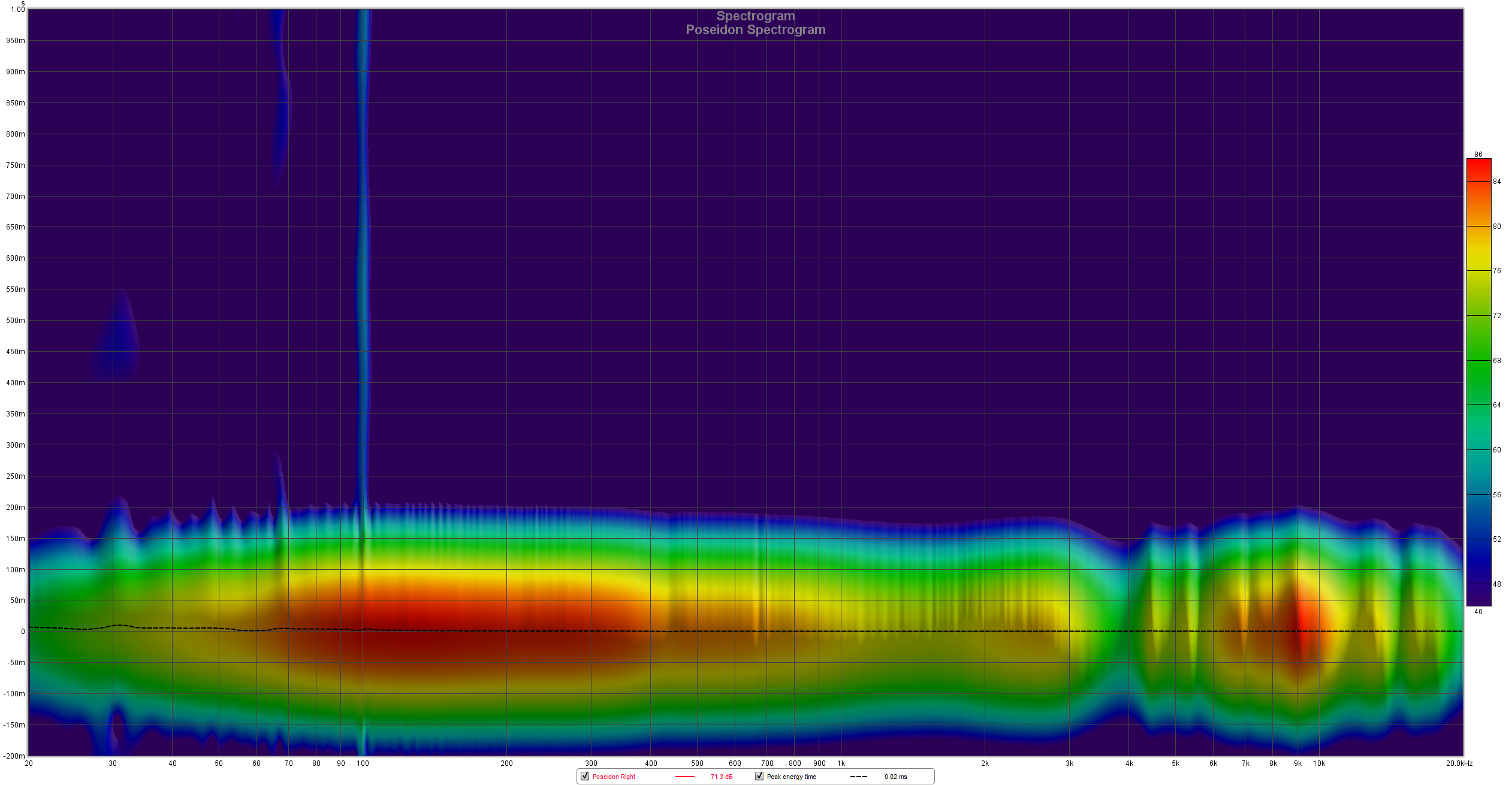
Spectrogram shows some unwanted ringing of the diaphragm/earcups in the 100 Hz region, which is difficult to tame in an open-back design. Apart from that, the drivers are perfectly controlled throughout the entire FR.
Overall, I have recorded an impressive driver matching a fast start and stop of the drivers, a minimal ringing of the earcups and an above decent THD reading. These aren’t even and linear in the FR, but I presume that was made on purpose for an enjoyable experience.
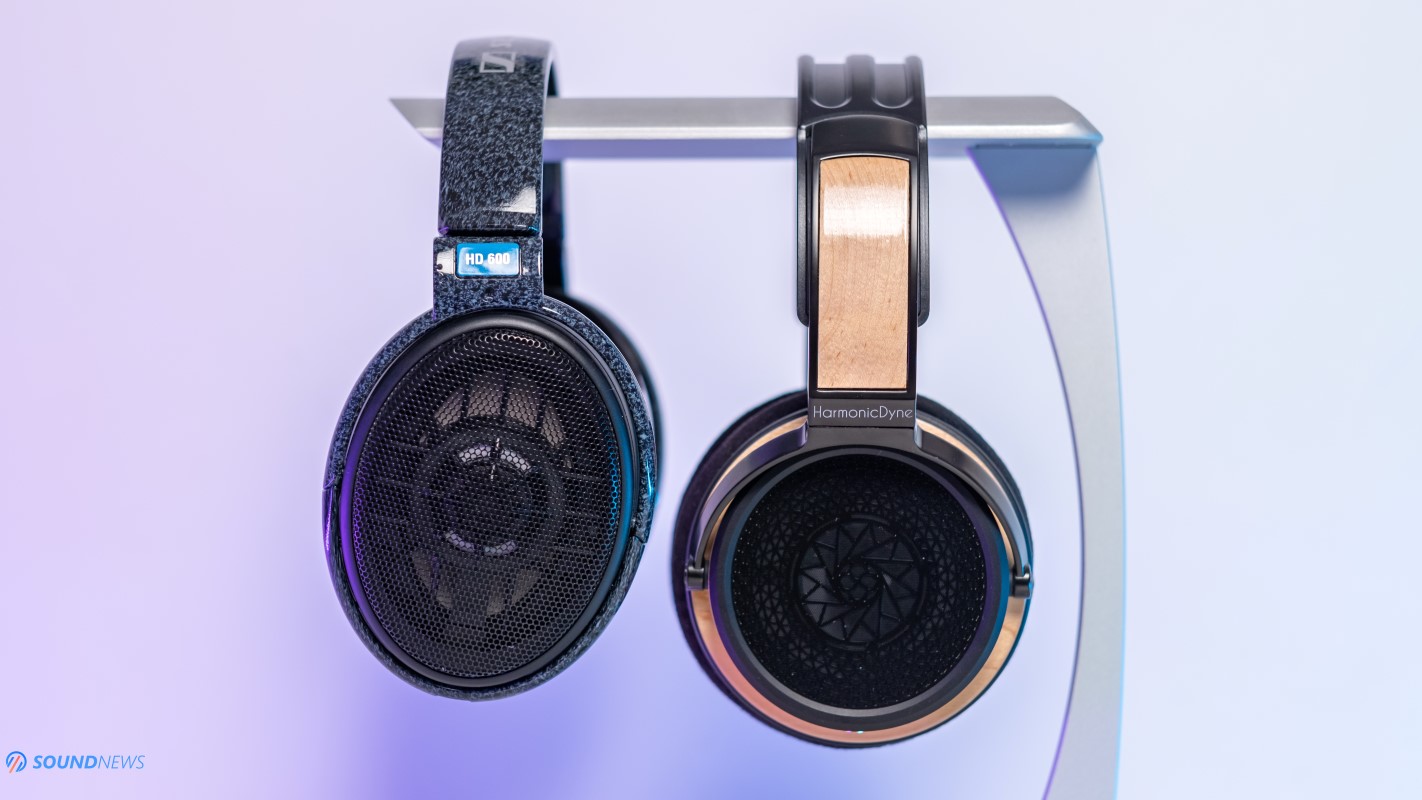
VIII. A Comparison
HarmonicDyne Poseidon ($280 Super Early/ $300 Early / $435 retail) VS Sennheiser HD600 ($400)
The only headphone in my possession right now that can stand a chance versus the god of the sea is Sennheiser HD600 that is costing more or less the same. Everybody knows HD600 by now and I’m pretty sure that serious headphiles tried some of its variations like HD650, HD580 or HD6XX for that matter. When it comes to accessories and build-quality, there is no contest as Poseidon is in another league completely. You are getting a fully balanced cable, a headphone adapter, a usable travel case and a nicer build quality all around.
When it comes to comfort, HD600 are clamping harder and I need to readjust them regularly, since I cannot use them for more than an hour without feeling pain around my ears. Poseidon clamps less and puts less pressure on top of my head, so I can listen to them for a few more hours without posing a problem.
Sound wise, HD600 goes with a safe tuning, choosing lots of midrange presence, an Okay-ish bass performance and a very relaxed treble delivery. I really like the HD600 when I need to relax my spirits and casually listen to some of my older recordings, since they can tame brightness, all the glare and mastering errors. HD600 is a smooth and easy rider, a gentle giant and that is precisely why people cannot get enough of them.
Poseidon is considerably more dynamic sounding, much faster, controlling the bass notes with a nicer grip, while delivering higher dynamics down low. It is almost the opposite of the Sennheiser tuning. Poseidon can be mean and aggressive at times, they go wild and really fast, always trying to keep up with the most demanding tunes. Poseidon will show a higher degree of micro-details hiding around your tracks and that can pose a problem with less than perfect recordings. If there is grain, hiss or noise in your setup, Poseidon will show that to you, while HD600 will be smoothing things up, adding a beatifying filter on top.
I always felt that HD600 offered a rounded frequency response, seriously rolling-off parts of the sub-bass and upper-treble, moving all the spotlights towards the midrange section. HD600 can drag you in with their elevated midrange performance, charming with sweeter vocals and longer decays of musical instruments. In this regard, Poseidon offers a much wider frequency response, there is more happening down low and in the upper registers, while trying to grab your attention with its mid-bass and upper treble regions. While HD600 can be described as going for an inversed V-shaped frequency response, Poseidon goes with a V-shaped FR that is so popular nowadays in Asian countries. When it comes to technicalities, there is no contest, everything is more impressive on the Poseidon, be it speed, slam, decay, FR, detail-retrieval, there is always something more with HarmonicDyne’s creation.
Stage size is a little bit wider on the Poseidon, while I find their depth equality impressive. Things are mostly happening inside my head with HD600, while Poseidon pushes all that energy outside, putting more air in between the notes, so I could listen even to crowded music all day long.
Overall, it really depends on what kind of listener you are. If you want to be carried away by music (especially acoustic and instrumental), then HD600 is a better headphone and if you want plenty of technicalities, unearthing higher levels of detail, sounding faster, while sounding bigger and wider on all axes, then Poseidon looks like a much better option.

My Conclusion
HarmonicDyne did not disappoint with their newest creation and everything that is being mentioned on their Kickstarter campaign is very true. You are getting a similar build quality, toning down their color scheme, while providing an improved transient response, a better detail retrieval, a bigger soundstage and a smoother top-end to their predecessor. Four key points were seriously improved, while costing just a little bit more. In the end, Poseidon didn’t sound like an entry level pair of headphones and more like an enthusiast grade Hi-Fi pair, that could rumble for a few rounds with some upper-class dynamic headphones. After finishing a full set of measurements, I was impressed by their technicalities and excellent driver matching. Sure enough, there are several drawbacks like a limited sub-bass extension and a dip in the 4 kHz region, but everything else performed at high level.
Price wise, if you hurry-up you can snatch a pair at a hefty discount by backing them via a Kickstarter campaign. Super early backers can get them at just $279, after first pairs are gone price will go up to $299 and if you miss their campaign entirely, you can get them from Linsoul at a retail price of $435, which is still a pretty good deal.
Considering all the sonic improvements, their accessories and build quality, it wouldn’t be fair without awarding them for that. Few things can still be improved upon, scoring a well-deserved Silver Award.

Are they rocking or are they sucking? That’s a question that you should explore and in case you get a pair, please come back and leave a comment below.
PROS:
- Great unboxing experience, awesome cable quality and its fully balanced
- Looks more or less the same, but its stealthier this time around
- Comfortable in long listening sessions
- It’s more balanced and even sounding to their predecessor
- More technical than full-bodied sounding
- Enhanced detail retrieval, challenging even pricier headphones
- Speedy, punchy and engaging – excellent transients
- One of the nicest mid-bass I’ve experienced at less than $500
- Extended treble performance, without being aggressive
- Reference sound at an affordable price
- Impressive set of measurements
- An incredible vale, especially if you back them up via Kickstarter
CONS:
- Sub-bass was downgraded to their predecessor
- There are a few dips in the frequency response
ASSOCIATED EQUIPMENT:
- DACs: SMSL D1SE, Audiobyte HydraVox & HydraZap, Matrix Audio Element X, Gold Note DS-10 Plus & PSU-10 Evo, Gustard X26 PRO, Topping D90SE, Musician Aquarius
- DAPs: FiiO M11 Plus LTD, M15, Shanling M8, M6 V21
- Headphone Amps: Flux Lab Acoustics Volot, Benchmark HPA4, Burson Soloist 3X, Musician Andromeda, SMSL SP400, Topping A90, Gustard H16
- Preamps: Musician Monoceros, Benchmark HPA4, Topping PRE90
- Power Amps: Benchmark AHB2 (x2), KECES S300, SMSL SA400, Burson Timekeeper 3i
- Loudspeakers: KEF Reference 3, Sound of Eden Crescendo UNO, Natural Sound NS-17
- IEMs: FiiO FD7, FA9, FH7, FH5S, Meze Rai Penta, Rai Solo, LittleDot Cu KIS, Hiby Crystal 6 & others
- Portable headphones: Sennheiser Momentum 2, Meze 99 Classics, Sony WH1000-XM4
- Full-sized headphones: HarmonicDyne Poseidon, Hifiman Susvara, HE1000SE, Arya, HE400SE, Audeze LCD-4, Erzetich Phobos 2021, Erzetich Mania, Kennerton Wodan, Magni, Gjallarhorn, Vali, M12S, Ollo S4X Reference, Apos Caspian, Sendy Peacock & Aiva
- Interconnects: QED Reference (x2), Topping TCX1 (x2)
- Speaker cables: Kimber PR8, Audioquest Type4
- Power Cables: Isotek EVO3 Premier (x3)
- Balanced Isolation Power Conditioners: PLiXiR Elite BAC1500 (stereo setup), Elite BAC400 (headphone setup)







